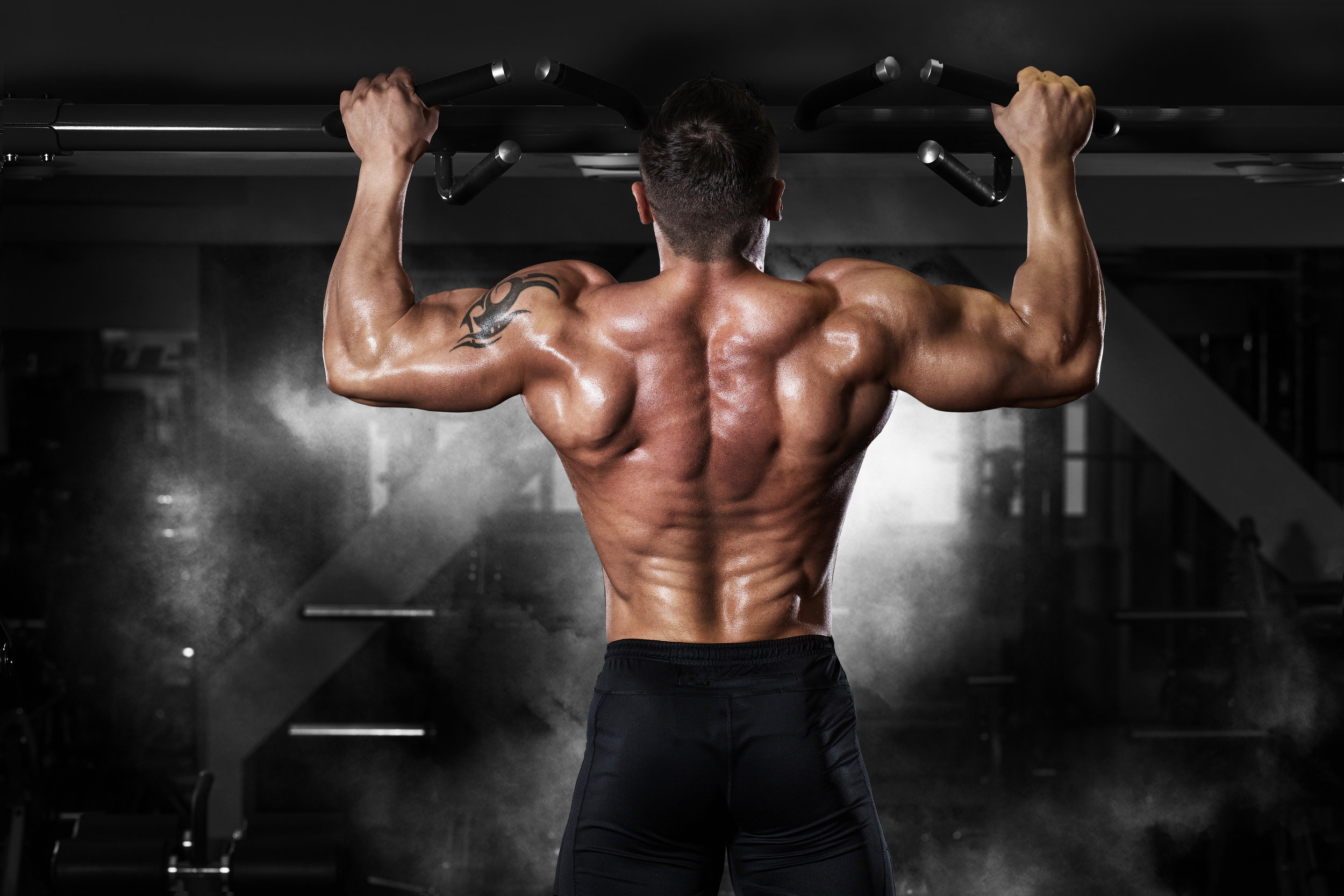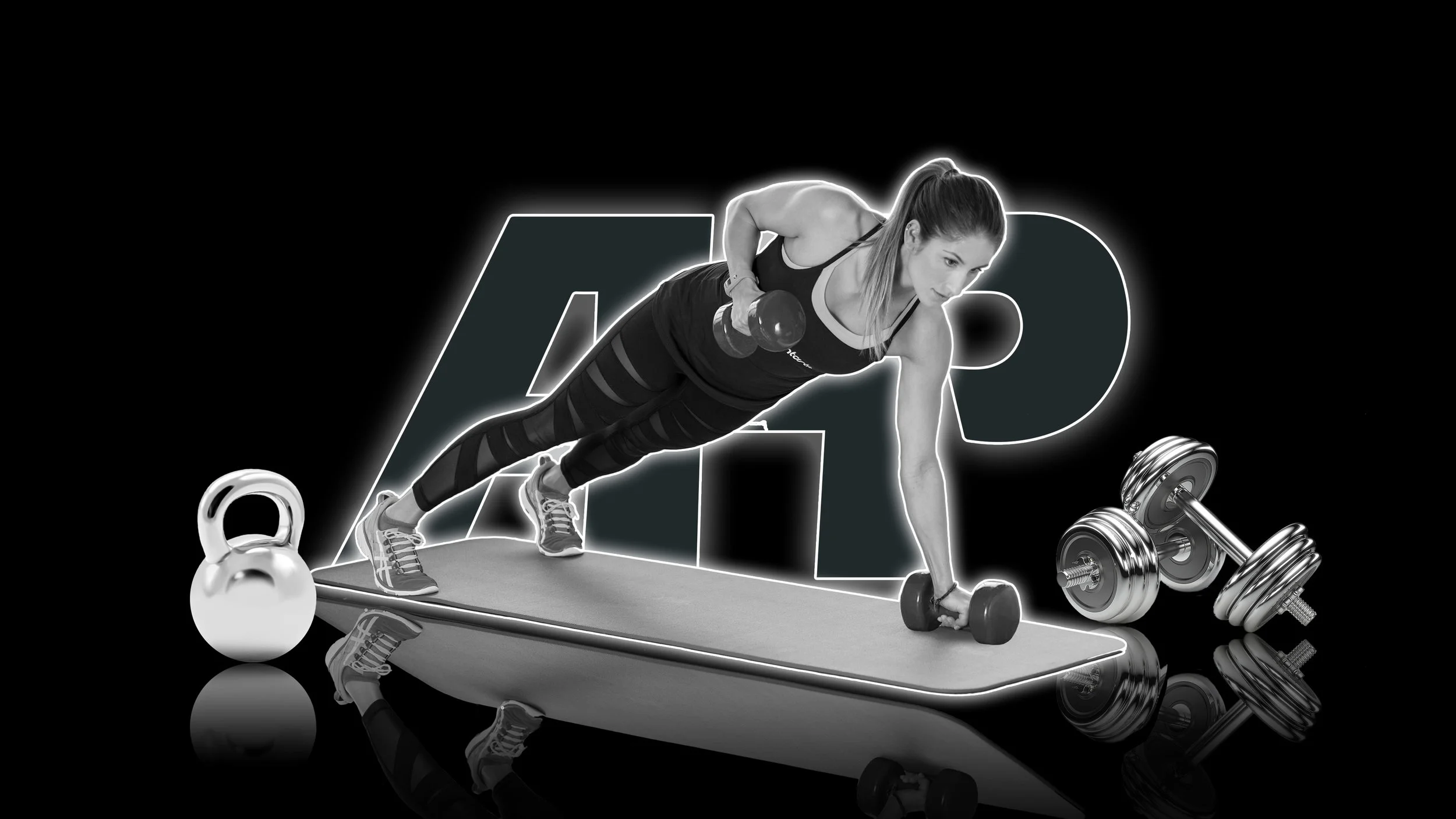Offset Pullups For Massive Back and Lats
Dr. Joel Seedman, Ph.D.
Offset training using asymmetrical loads or asymmetrical positions is one of my favorite methods for improving body mechanics, muscle function, symmetry, and movement efficiency. While I typically apply offset loading to barbell movements and dumbbell exercises, it can also be applied to pullups by using an offset grip. Simply perform pullups on a station that provides different grip height positions then perform pullups. Here’s one of my NFL athletes Marquell Beckwith showing how it’s done with a double offset position weighted chain pullup. In other words the hands aren’t just at different heights but they’re also mixed as one is pronated and the other is supinated.
There are seven benefits of this method.
1. As asymmetrical as it is, the offset pullup actually helps address asymmetries and weaknesses. That’s because you’re pulling slightly more with the higher arm, making it somewhat similar to a single arm pulldown or single arm pullup. However the lifter should still try to pull as equally as possible with both arms throughout. Don’t be surprised if one side is significantly more challenging than the other.
2. One of the biggest issues that can contribute to asymmetrical positioning on pullups occurs when individuals get overly concerned and distracted with how symmetrical the movement feels. While it’s critical to pay attention to symmetrical loading and symmetrical positioning it’s actually more important to focus on executing the basic steps of the pullup with proper cues such as tight core, proper posture, controlled eccentric, shoulders packed, scapula depressed and retracted, torso alignment, and general limb position etc.
Becoming overly concerned with symmetrical positioning or equal tension across sides of the body can distract the lifter from these other more important cues. Ironically this can degrade their symmetrical positioning even more so. This offset pullup helps address this as the lifter inherently approaches each set understanding that the movement will feel semi asymmetrical throughout therefore they don’t have to be overly concerned with their sense of symmetry. Instead they can focus more so on basic pullup and chin-up cues and general biomechanics with less distraction about how symmetrically aligned or symmetrically loaded they are. As a result I’ve actually seen this be one of the most effective methods for enhancing symmetrical loading and positioning.
3. When it comes to dialing in your pullup and chin-up form, learning to engage the core is always a surefire way to produce immediate improvements in form. Offset pullups force the lifter to activate their core to a greater degree as a means of stabilizing the movement. If the core gets lose the body will actually twist and rotate due to the asymmetrical position.
4. Offset pullups are one of the most effective pullup variations I’ve ever used for teaching athletes optimal range of motion on the concentric phase. Most individuals tend to over-pull on pullups by attempting to pull themselves too high at the top of the movement which can lead to lack of back engagement not to mention shoulder issues. The offset position helps minimize this as over-pulling with an asymmetrical position produces very exaggerated misalignment giving the lifter immediate feedback about where to stop on the concentric phase.
5. The offset pullup also promotes optimal eccentric range of motion. Similar to the above point, many individuals over-stretch at the bottom and collapse and hang on their tendons and ligaments rather than maintain a level of muscular tightness and spinal rigidity. The offset pullup helps eliminate this as the core musculature, spinal stabilizers, and shoulder stabilizers are all forced to stay engaged thereby minimizing any collapsing effect.
6. The offset elevation pullup requires the lifter to use stricter, slower, and smoother pulling mechanics inevitably leading to greater metabolic stress, mechanical tension, and muscle damage. As a result they’re incredibly effective as a functional hypertrophy exercise not only for the entire upper back and lats but also the biceps and forearms.
7. One of the first things my athletes will mention on offset pullups is how much they feel their forearms and grip are getting worked. That’s because the offset position requires greater full body tension which inevitably produces increased grip activation and forearm recruitment. This also leads to greater concurrent activation potentiation and irradiation thereby producing increased neural drive and motor control throughout the kinetic chain.
Try performing several sets of 6-10 reps (3-5 reps on each side) during your next back workout. Just be prepared to drop your numbers or load by at least 20% as these are unusually challenging.
Offset Weighted Pullups
Similar to the offset position/grip height technique, the offset pullup protocol can also be performed by implementing offset weights/loads rather than offset grip positions.
Simply place a kettlebell, chain, or hanging band weight on one foot/leg and perform traditional pullups as I’m shown doing in the video alongside two of my awesome clients Ben Lai and Leslie Petch. I suggest using the dorsiflexion foot position with straight legs or knee flexion leg position as both of these help dial in spinal rigidity and postural alignment as well as improve full body tension.
Similar to the offset grip height pullups, the individual will be forced to dial in their mechanics by locking in their form, resisting rotation, tightening their core, and maintaining proper spinal alignment. These are also surprisingly taxing on the upper back and lats as the amount of intramuscular tension and motor unit recruitment throughout the lats and upper back is unusually high. As a result they’re not only incredibly effective for cleaning up pullup mechanics and technique but also for building functional strength and mass in the upper torso. I recommend performing several sets of 3-5 reps on each side.
Offset Lat Pulldowns
The offset protocol can also be applied to lat pulldowns simply by placing one hand closer to the center of the bar and the other hand closer to the outside of the bar then switching midway through the set. The goal is to not let the bar tilt or twist. The inside arm (the one closest to the center) will be the dominant arm in this method. Similar to the above pullups, lock the core and keep proper postural alignment.
Offset Angled Pullups
The offset pullup protocol can also be applied using the offset angled method. To apply the offset angled protocol to pullups and inverted rows, simply place a barbell on top of a squat rack that has safety pins set to staggered heights. Here I have two of my NFL combine athletes Julian Williams and Bryce Canady showing how it’s done.
On a side note you’ll notice they you use a slightly more compact range of motion during these as attempting to use too large of an ROM can pull the body excessively out of alignment particularly in the shoulders and scapular regions. In fact, this is a common quality amongst many offset position exercises as a more compact ROM is typically ideal to maintain proper alignment and spinal positioning. With that said the there are 4 unique benefits of this offset angled method when it comes to pullups and chin-ups.
1. As asymmetrical as the movement is, the offset angled pullup actually helps address asymmetries and weaknesses similar to the other offset pull-ups. That’s because you’re pulling slightly more with the higher arm, making it somewhat similar to a single arm pulldown or single arm pullup. However the lifter should still try to pull as equally as possible with both sides of their body and avoid moving into an overly asymmetrical position. With that said, don’t be surprised if one side is significantly more difficult.
2. When it comes to dialing in your pullup and chin-up form, learning to engage the core is always a surefire way to produce immediate improvements in form. Offset angled pullups force the lifter to activate their core to a greater degree as a means of stabilizing the movement and resisting rotational forces and lateral flexion forces. In other words if the core gets loose the body will actually twist and rotate due to the asymmetrical position. It should also be noted that the main difference between these offset angled pull-ups and other offset pullup protocols is that the angled position not only wants to shift one side of the body higher than the other but it also wants to produce significant rotational and lateral flexion forces on the torso (something the other versions don't produce to the same degree)
3. The offset elevation pullup requires the lifter to use stricter, slower, and smoother pulling mechanics inevitably leading to greater metabolic stress, mechanical tension, and muscle damage. As a result they’re incredibly effective as a functional hypertrophy exercise not only for the entire upper back and lats but also the biceps and forearms.
4. One of the first things my athletes will mention on offset angled pullups is how much they feel their forearms and grip are getting worked. That’s because the offset position requires greater full body tension which inevitably produces increased grip activation and forearm recruitment. In addition, the barbell itself has a tendency to roll on the pins creating even greater stress to the girp and forearms. Each of these grip-related components lead to greater concurrent activation potentiation and irradiation thereby producing increased neural drive and motor control throughout the kinetic chain.
Vertical Monkey Bars
Although it's not exactly offset training, vertical monkey bars provides a similar stimulus as offset pull-ups and chin-ups. In fact, If you’re looking for a way to absolutely annihilate your lats, grip, and core musculature all at once (as well as other stabilizers), try this over under vertical monkey bars superset with weighted chin-ups demonstrated by my NFL athlete Bryce Jones.
This protocol can be done with staggered grip heights as shown in the video (one grip 4-8 inches above the other) or simply done on a straight bar by continually switching from a pronated to a supinated grip each time you re-grip the bar.
The key lies in quickly releasing then re-gripping throughout the set as this combination of momentary single arm loading combined with tension in the semi-stretched position annihilates the upper back, lats, grip, and arms. In addition, the core must work overtime to minimize lateral flexion and rotation of the torso as well as swinging that will want to occur. To keep these factors to a minimum the entire musculature of the core and abs as well as the spinal stabilizers will be forced to activate.
Also notice how Bryce switches which hand he leads with mid-way through the set. This is an important feature as leading with one side can develop asymmetries as the body will tend to favor leading with the stronger arm. Once you finish performing at least up and down reps on both sides try cranking out a few additional pullups and chin-ups as Bryce shows in the video. Just be prepared for some serious soreness in the upper back and lats followed by some incredible hypertrophy in the upper body.
Offset Suspender Pullups
Suspender pullups provide one of the most effective methods I’ve ever used for performing offset loading pullups as my awesome figure athlete Leslie Petch shows here.
Simply use only one band loaded on one side of the body and voila you have the perfect offset loading protocol. Just be prepared to fire the daylights out of your core and lats to insure your body does not twist, tilt, or sway.
Bonus: Partner Perturbation Trap Bar Pull-Ups
If you’re still in need of another pullup variation to help clean up form and asymmetries, try this unique partner perturbation trap bar pullup.
Perturbation training has been scientifically shown to improve neuromuscular efficiency and recruitment patterns as the unpredictable oscillations with partner taps creates oscillating kinetic energy which forces the lifter to activate every stabilizer around the moving joints. In addition it teaches the lifter to be incredibly tight and locked in as perturbation training has also been shown to produce concurrent activation potentiation and irradiation as well as a host of other neuromuscular benefits. In other words you get increased neural drive to all the extremities and stabilizers as your body works overtime to lock the movement in. The core musculature also receives intense stimulation as the lifter is required to fire the core and abs as a means of locking the movement in and creating greater motor control.
While this technique is typically applied to lower body movements, core exercises, balance drills, and upper body presses (i.e. bottoms up movements), this same concept can also be applied to pullups as I show here with my awesome client Todd Weiland. Simply place a trap bar on the safety pins of a squat rack and have a partner quickly and unpredictably press or pull on the sides of the trap bar.
This results in sudden oscillations, tilts, and perturbations to the trap bar that the lifter must resist. In addition, the lats, biceps, shoulder stabilizers, and forearms get absolutely pummeled as you’ll be forced to use incredibly strict and smooth form as anything less simply won’t suffice.
If you’re looking for a training program that teaches you how to implement unique pullup variations such as these into your routine check out my Complete Templates.


















































